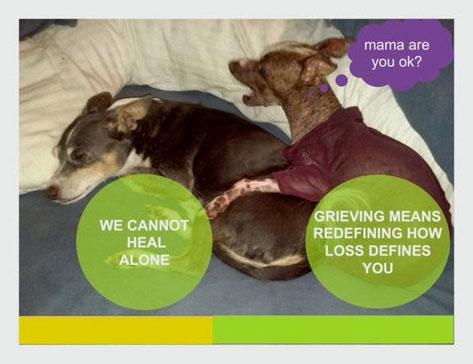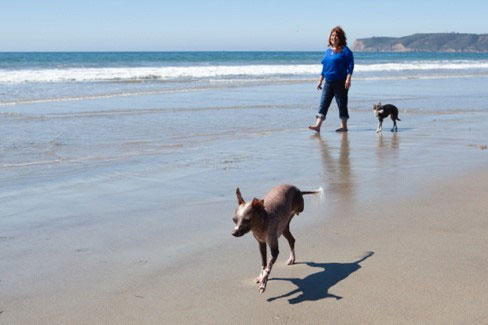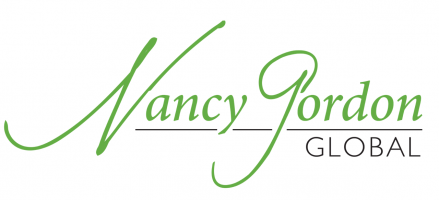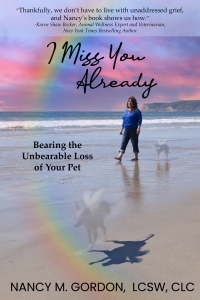Navigating the Journey to the Rainbow Bridge
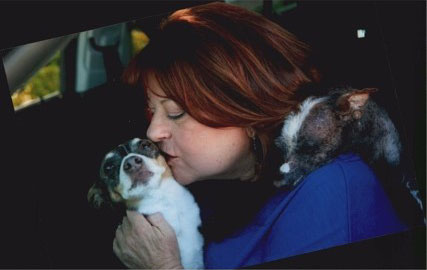
Are you facing the heartbreaking experience of watching your beloved pet enter the pre-boarding flight over to Rainbow Bridge? You cry out to cancel their flight. You're desperate to stop them from boarding. You try everything imaginable but, to your horror, you realize you cannot. control. death.
What??? This can NOT be happening. I was in a state of shock and denial that I could not stop my dogs from boarding the plane! Confronted with this most unbearable feeling, I honestly didn't know how I would get through this, even though I'm a loss and grief expert! My grief felt like a nightmare from which I couldn't wake up.
This is called Anticipatory Grief. It's a natural human response when you know that your loss is on the horizon, whether that's years or moments away. When Rainbow Bridge looms on the horizon of your vision, anticipatory grief is what bubbles up as the first experience when impending loss becomes an irrefutable reality.
Can we bear it, much less imagine how we will live without them? I felt that way, but through my own journey with chronic illness and disability, I found my resilience through 7 powerful practices that transformed my loss into love and grief into growth.
When I applied these same 7 practices to my journey of "lifting UP"™ Toaster and Pink, I formed the foundation of my transformational pet grief methodology. The first practice, called "2-Sided Surrender," is the focus of this article.
♫♫♫ Comin' round the Corner When It Comes When It Comes ♫♫♫
The 5 Well-Known Stages of Grief … But Wait, There's More!
Everyone goes through five identifiable grief stages after we lose a loved one. Elizabeth Kubler Ross pioneered the first definitions as shock, anger, depression, bargaining, and acceptance. But wait, there's more! Before we even lose our beloved, we experience anticipatory grief, which I consider the very first stage of grief (unless loss is sudden and unexpected).
Within Anticipatory grief, we experience ALL the other 5 stages of grief, so essentially, we go through grief stages twice: before loss and after loss.
It's natural for grief to begin even years before your pet actually parts, and no matter what, the first response is shock and denial. You may recognize the resounding screams heard in this first stage of grief: "NO! WAIT!" "IT'S TOO SOON!" "I'M NOT READY!" "THIS IS UNBEARABLE!" And, my own favorite, "I MISS YOU ALREADY."
But no matter how loud we scream, no matter what we do, we know deep down that we can't stop loss. It. Is. Coming. "NOOOOOOO!"
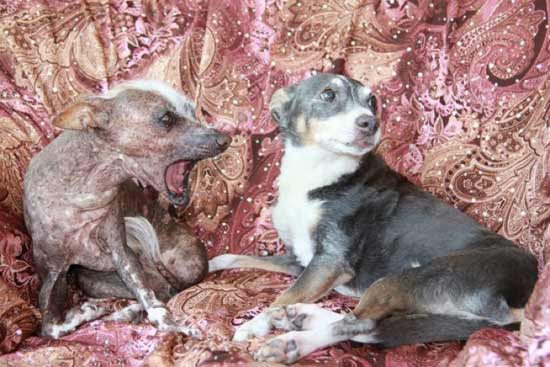
As the veil of denial is pierced when symptoms worsen, we move into the next response, which is a flood of emotions, such as anxiety, depression, fear, and resistance. The end result of this flood is a river of pure angst as we see their loss "comin' round the corner." Now we are swimming in anticipatory grief, feeling we may drown in our sorrow, often alone and without a paddle.
Surrendering: The Paddle That Floats Your Boat
How we respond to anticipatory grief presents an important pre-cursor for how we heal the grief after our loss. When we are confronted with this unbearable impending loss, we naturally resist it. In that moment, we can't surrender and "accept what is" and therefore we "can't let go."
When I first understood the practice of surrendering as I became chronically ill and had to file for disability, I thought "accepting what is" was the same as "letting go." It's not. In my journey with Toaster and then Pink, 9 months later, I discovered that, indeed, they are 2 sides of the same coin.
Surrendering Toaster, 'Holding Paws'
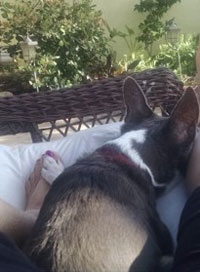 Toaster was my "doggie soul mate," my first unconditional love. When I began to see Rainbow Bridge on the horizon, I felt gut-wrenching, heartbreaking pain facing what was unfolding: she was unmistakably getting closer to death.
Toaster was my "doggie soul mate," my first unconditional love. When I began to see Rainbow Bridge on the horizon, I felt gut-wrenching, heartbreaking pain facing what was unfolding: she was unmistakably getting closer to death.
I knew I had to learn how to bear that decision and meet her at that dreaded horizon. But how?
Quality of life (QOL) scale is known as one of the main assessment tools veterinarians and pet parents must understand and consider when to surrender the pet.
As Toaster became more disabled from her chronic conditions, she required increased home care and hospitalizations. Now I'm beginning to be knee deep in that river of sorrow.
I began whispering in Toaster's ear each morning "we have another day!" and at bedtime, I would whisper "we had another day!" This is how I navigated my anticipatory grief: I created a routine to face it with a ritual to stay present in the moment with her and with my grief and be grateful.
As we reversed roles, another current of that river of sorrow was splashing my face. I couldn't deny that she was starting to walk that tightrope between great discomfort and actual suffering. Watching this occur over time created a painful conflict in decision making to consider euthanasia.
I also experienced cognitive dissonance, which is the mental ping pong between 2 conflicting emotions, thoughts, and decisions. In this case, I didn't want her to cross that tightrope and suffer, yet I didn't want to let her go too soon.
As Toaster's caregiving needs multiplied, she required more physical assistance. At first, she resisted this. But soon, she began to bark for help! When she started this new behavior, it hit me: she had surrendered to the fact she was more disabled and "accepts what is."
Wow. And then I noticed that not only had she surrendered and accepted this, but she now enjoyed being carried around! Without hesitation, she barked for help up the stairs, onto the bed, or asked me to "fetch" her water.
And, of course, she happily dined in bed with excellent table service. Whether you like it or not, this side of "2-Sided Surrender" is the only path to staying present in the peace of "what is," so you might as well enjoy it!
Surrendering Pink, 'Holding Paws'
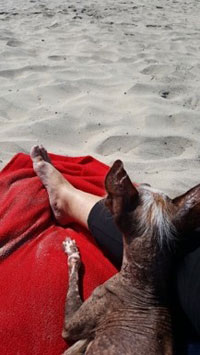 Pink was my guardian angel and my most profound teacher. I also clung to Pink as my last remnant of Toaster. When you only have one pet left, you may also feel you are losing the last remnant of unconditional pet love, as well as your role as a pet parent.
Pink was my guardian angel and my most profound teacher. I also clung to Pink as my last remnant of Toaster. When you only have one pet left, you may also feel you are losing the last remnant of unconditional pet love, as well as your role as a pet parent.
My journey of the "letting go" in 2-Sided Surrender began when I could no longer deny that Pink's suffering became a question mark as I noticed significant signs where she "appeared unhappy" and "not her old self."
In facing anticipatory grief, we also have to recognize our own suffering. I, too, had begun to suffer, like any worn out caregiver, expending all my time, energy, and money to focus on making her better, happier, and to escape death.
The compulsion to do everything imaginable to save Pink became my grief reaction and resistance to surrendering and letting her go. It felt unbearable to face her dying.
Despite my helplessness, I maintained hope, through the guise of denial, as I witnessed her decline. Though I couldn't stop it, I couldn't let her go. I was stuck in HOPE … which, to be honest, became really more about the avoidance of loss and grief.
Ultimately, compassionately acknowledging the beginning of both Pink's and my own suffering snapped me into navigating the other side of 2-Sided Surrender: the art of letting go. I created a ritual with Pink at this time, which helped me let go of her.
Every day I acknowledged my gratitude for all she gave me in her 14 years. I acknowledged my loss and grief, and at the same time, the deep love I had for her by whispering in her ear everyday "I miss you already … and I could not love you more."
Growing Through Grief, Rising to Resilience
Anticipatory grief is often not recognized, understood, nor well supported with respect, compassion, and guidance. Many pet parents feel A-L-O-N-E and stressed out during this most delicate, precious time remaining with their pet.
That's why it's my mission to change that experience by educating pet parents not only about the profound value of facing pet loss, but also how to navigate the journey of pet loss and grief before, during, and after the Rainbow Bridge.
When we allow the healing of grief to crack us open, to teach us how, in fact, to live and love, we realize the value of this transformational grief work. Above all, in this stage lies the only opportunity that remains before your pet passes in which you can not only minimize the trauma of parting but "lift UP"™ your pet instead of "putting them down".
Unless you face impending loss, you will not be able to minimize the trauma for yourself or your pet; you will not be able to truly uplift your pet because you are not truly, fully present if you are not facing your grief and moving through it with them.
Admittedly, it's not easy. There is nothing like facing losing your pet, or any loved one, to crack your heart wide open. You can either heal and grow through surrendering to what is and letting go, or keep your grief locked in your heart and miss those last precious moments being present with your pet before they part.
This is the value of learning the practice of 2-Sided Surrender. It actually heals your heart, knowing you honored your pet by being lovingly present in the service of ushering them out. They will feel and know the unconditional love from which you surrender them. Practicing 2-Sided Surrender is using grief in a way that positively transforms you and uplifts your pet at the same time. What a profound parting grace you gift your beloved and yourself!
Yes, I know how (beyond) painful it is to face pet loss. Yet, I'm always reminded of the greater benefit of doing so, in the beautiful sentiment by the late musician Lenard Cohen, "There is a crack in everything. That's how the light gets in."
